A Study on the Freeze–Thaw Damage and Deterioration Mechanism of Slope Rock Mass Based on Model Testing and Numerical Simulation
Abstract
:1. Introduction
2. Physical Model Testing of Freeze–Thaw Damage and the Deterioration Mechanism of Slope Rock Mass
2.1. Design of Physical Model of Freeze–Thaw Slope
2.2. Determining Similar Materials
2.3. Test System of the Freeze–Thaw Simulation
2.4. Monitoring System for Temperature, Displacement and Frost-Heave Force
2.5. Procedures of Freeze–Thaw Test
3. Analysis of Physical Model Test Results
3.1. Temperature Field Analysis of Freeze–Thaw Rock Mass
3.2. The Progressive Failure Process of Freeze–Thaw Slope Rock Mass
4. Numerical Simulations of Frost-Heave Failure of the Slope Rock Mass
4.1. Foundations of RFPA2D-Thermal
4.2. Numerical Model of a Slope with an Ice Crack
4.3. The Analysis of the Stress and Crack Propagation Law of the Slope Rock Mass under Negative Temperature
4.4. Influence of Fissure Water Freezing Rate on Damage and Deterioration of Slope Rock Mass under Negative Temperature
5. Conclusions
Author Contributions
Funding
Institutional Review Board Statement
Informed Consent Statement
Data Availability Statement
Conflicts of Interest
References
- Henry, H.A.L. Soil freeze–thaw cycle experiments: Trends, methodological weaknesses and suggested improvements. Soil Biol. Biochem. 2007, 39, 977–986. [Google Scholar] [CrossRef]
- Congreves, K.A.; Wagner-Riddle, C.; Si, B.C.; Clough, T.J. Nitrous oxide emissions and biogeochemical responses to soil freezing-thawing and drying-wetting. Soil Biol. Biochem. 2018, 117, 5–15. [Google Scholar] [CrossRef]
- Smith, N.V.; Saatchi, S.S.; Randerson, J.T. Trends in high northern latitude soil freeze and thaw cycles from 1988 to 2002. J. Geophys. Res.-Atmos. 2004, 109, D12101. [Google Scholar] [CrossRef]
- Freppaz, M.; Williams, B.L.; Edwards, A.C.; Scalenghe, R.; Zanini, E. Simulating soil freeze/thaw cycles typical of winter alpine conditions: Implications for N and P availability. Appl. Soil Ecol. 2007, 35, 247–255. [Google Scholar] [CrossRef]
- Kreyling, J.; Beierkuhnlein, C.; Pritsch, K.; Schloter, M.; Jentsch, A. Recurrent soil freeze–thaw cycles enhance grassland productivity. New Phytol. 2008, 177, 938–945. [Google Scholar] [CrossRef]
- Edwards, L.M. The effects of soil freeze–thaw on soil aggregate breakdown and concomitant sediment flow in Prince Edward Island: A review. Can. J. Soil Sci. 2013, 93, 459–472. [Google Scholar] [CrossRef]
- Shin, Y.; Choi, J.C.; Quinteros, S.; Svendsen, I.; L’Heureux, J.; Seong, J. Evaluation and monitoring of slope stability in cold region: Case study of man-made slope at Øysand, Norway. Appl. Sci. 2020, 10, 4136. [Google Scholar] [CrossRef]
- Gowthaman, S.; Iki, T.; Nakashima, K.; Ebina, K.; Kawasaki, S. Feasibility study for slope soil stabilization by microbial induced carbonate precipitation (MICP) using indigenous bacteria isolated from cold subarctic region. SN Appl. Sci. 2019, 1, 1480. [Google Scholar] [CrossRef] [Green Version]
- Mufundirwa, A.; Fujii, Y.; Kodama, N.; Kodama, J. Analysis of natural rock slope deformations under temperature variation: A case from a cool temperate region in Japan. Cold Reg. Sci. Technol. 2011, 65, 488–500. [Google Scholar] [CrossRef] [Green Version]
- Ballantyne, C.K.; Stone, J.O. Timing and periodicity of paraglacial rock-slope failures in the Scottish Highlands. Geomorphology 2013, 186, 150–161. [Google Scholar] [CrossRef]
- Krautblatter, M.; Funk, D.; Günzel, F.K. Why permafrost rocks become unstable: A rock–ice-mechanical model in time and space. Earth Surf. Proc. Land. 2013, 38, 876–887. [Google Scholar] [CrossRef] [Green Version]
- Murton, J.B.; Peterson, R.; Ozouf, J.C. Bedrock fracture by ice segregation in cold regions. Science 2006, 314, 1127–1129. [Google Scholar] [CrossRef] [PubMed] [Green Version]
- Winkler, E.M. Frost damage to stone and concrete: Geological considerations. Eng. Geol. 1968, 2, 315–323. [Google Scholar] [CrossRef]
- Kostromitinov; Nikolenko, K.N.; Nikitin, B.D. Testing the strength of frozen rocks on samples of various forms. In Increasing the effectiveness of mining industry in Yakutia. Int. J. Rock Mech. Min. Geomech. Abstr. 1974, 12, 32–37. [Google Scholar]
- Yamabe, T.; Neaupane, K.M. Determination of some thermo-mechanical properties of Sirahama sandstone under subzero temperature condition. Int. J. Rock Mech. Min. 2001, 38, 1029–1034. [Google Scholar] [CrossRef]
- Yavuz, H.; Altindag, R.; Sarac, S.; Ugur, I.; Sengun, N. Estimating the index properties of deteriorated carbonate rocks due to freeze–thaw and thermal shock weathering. Int. J. Rock Mech. Min. 2006, 43, 767–775. [Google Scholar] [CrossRef]
- Khanlari, G.; Sahamieh, R.Z.; Abdilor, Y. The effect of freeze–thaw cycles on physical and mechanical properties of Upper Red Formation sandstones, central part of Iran. Arab. J. Geosci. 2015, 8, 5991–6001. [Google Scholar] [CrossRef]
- Ghobadi, M.H.; Taleb Beydokhti, A.R.; Nikudel, M.R.; Asiabanha, A.; Karakus, M. The effect of freeze–thaw process on the physical and mechanical properties of tuff. Environ. Earth Sci. 2016, 75, 846. [Google Scholar] [CrossRef]
- Momeni, A.; Abdilor, Y.; Khanlari, G.R.; Heidari, M.; Sepahi, A.A. The effect of freeze–thaw cycles on physical and mechanical properties of granitoid hard rocks. Bull. Eng. Geol. Environ. 2016, 75, 1649–1656. [Google Scholar] [CrossRef]
- Sarici, D.E.; Ozdemir, E. Determining point load strength loss from porosity, Schmidt hardness, and weight of some sedimentary rocks under freeze–thaw conditions. Environ. Earth Sci. 2018, 77, 62. [Google Scholar] [CrossRef]
- Al-Omari, A.; Beck, K.; Brunetaud, X.; Török, Á.; Al-Mukhtar, M. Critical degree of saturation: A control factor of freeze–thaw damage of porous limestones at Castle of Chambord, France. Eng. Geol. 2015, 185, 71–80. [Google Scholar] [CrossRef]
- Martínez-Martínez, J.; Benavente, D.; Gomez-Heras, M.; Marco-Castaño, L.; Ángeles García-del-Cura, M. Non-linear decay of building stones during freeze–thaw weathering processes. Constr. Build. Mater. 2013, 38, 443–454. [Google Scholar] [CrossRef]
- De Argandona, V.G.R.; Rey, A.R.; Celorio, C.; Suárezdel Río, L.M.; Calleja, L.; Llavona, J. Characterization by computed X-ray tomography of the evolution of the pore structure of a dolomite rock during freeze–thaw cyclic tests. Phys. Chem. Earth Part A Solid Earth Geod. 1999, 24, 633–637. [Google Scholar] [CrossRef]
- Ruedrich, J.; Kirchner, D.; Siegesmund, S. Physical weathering of building stones induced by freeze–thaw action: A laboratory long-term study. Environ. Earth Sci. 2011, 63, 1573–1586. [Google Scholar] [CrossRef] [Green Version]
- Davidson, G.P.; Nye, J.F. A photoelastic study of ice pressure in rock cracks. Cold Reg. Sci. Technol. 1985, 11, 141–153. [Google Scholar] [CrossRef]
- Rode, M.; Schnepfleitner, H.; Sass, O. Simulation of moisture content in alpine rockwalls during freeze–thaw events. Earth Surf. Proc. Land. 2016, 41, 1937–1950. [Google Scholar] [CrossRef]
- Yahaghi, J.; Liu, H.; Chan, A.; Fukudaab, D. Experimental and numerical studies on failure behaviours of sandstones subject to freeze–thaw cycles. Transp. Geotech. 2021, 31, 100655. [Google Scholar] [CrossRef]
- Neaupane, K.M.; Yamabe, T.; Yoshinaka, R. Simulation of a fully coupled thermo–hydro–mechanical system in freezing and thawing rock. Int. J. Rock Mech. Min. 1999, 36, 563–580. [Google Scholar] [CrossRef]
- Neaupane, K.M.; Yamabe, T. A fully coupled thermo-hydro-mechanical nonlinear model for a frozen medium. Comput. Geotech. 2001, 28, 613–637. [Google Scholar] [CrossRef]
- Tang, C.A.; Tang, S.B.; Gong, B.; Bai, H.M. Discontinuous deformation and displacement analysis: From continuous to discontinuous. Sci. China Technol. Sc. 2015, 58, 1567–1574. [Google Scholar] [CrossRef]
- Kang, F.; Li, Y.; Tang, C.; Li, T.; Wang, K. Numerical Study on Thermal Damage Behavior and Heat Insulation Protection in a High-Temperature Tunnel. Appl. Sci. 2021, 11, 7010. [Google Scholar] [CrossRef]
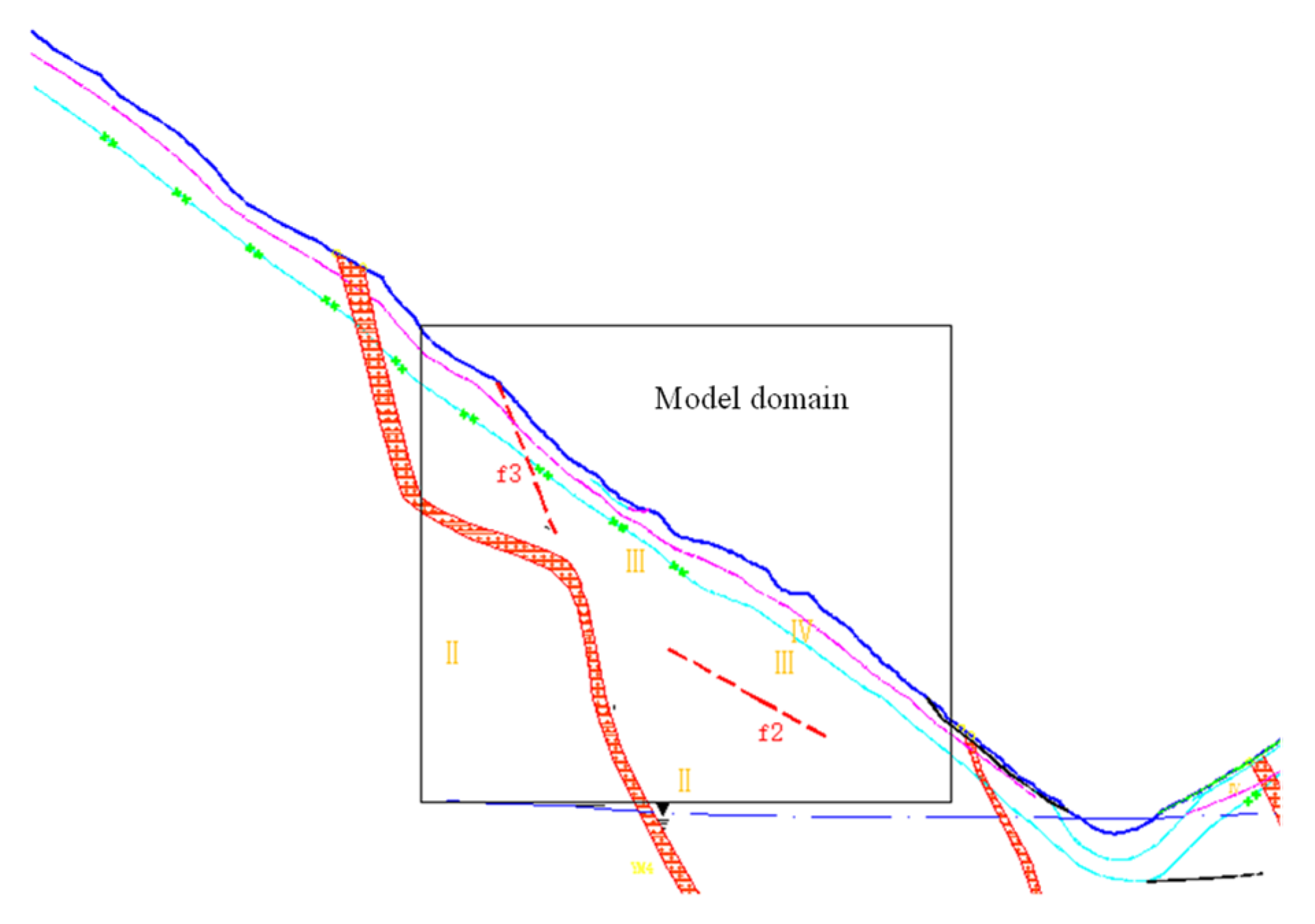
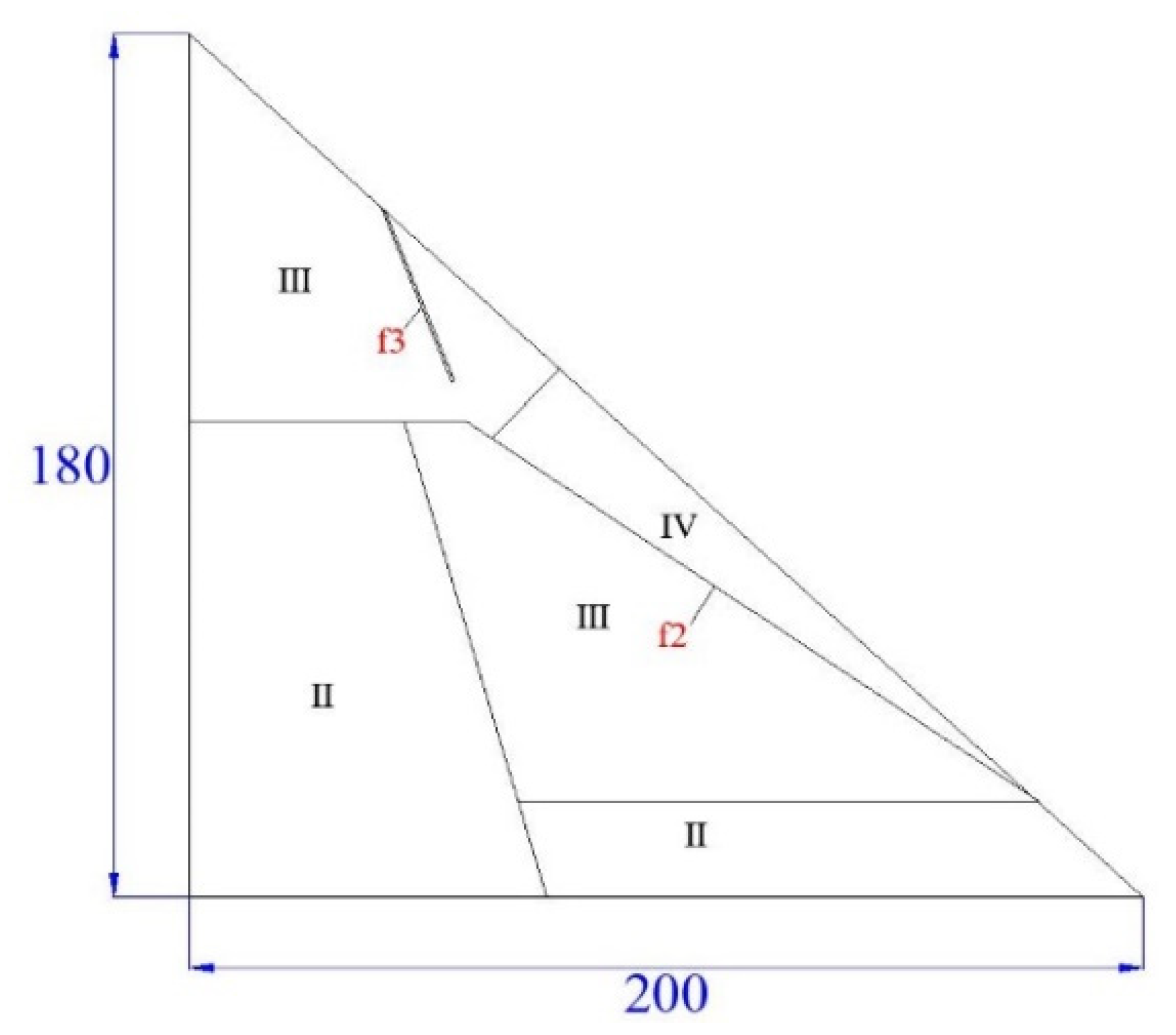
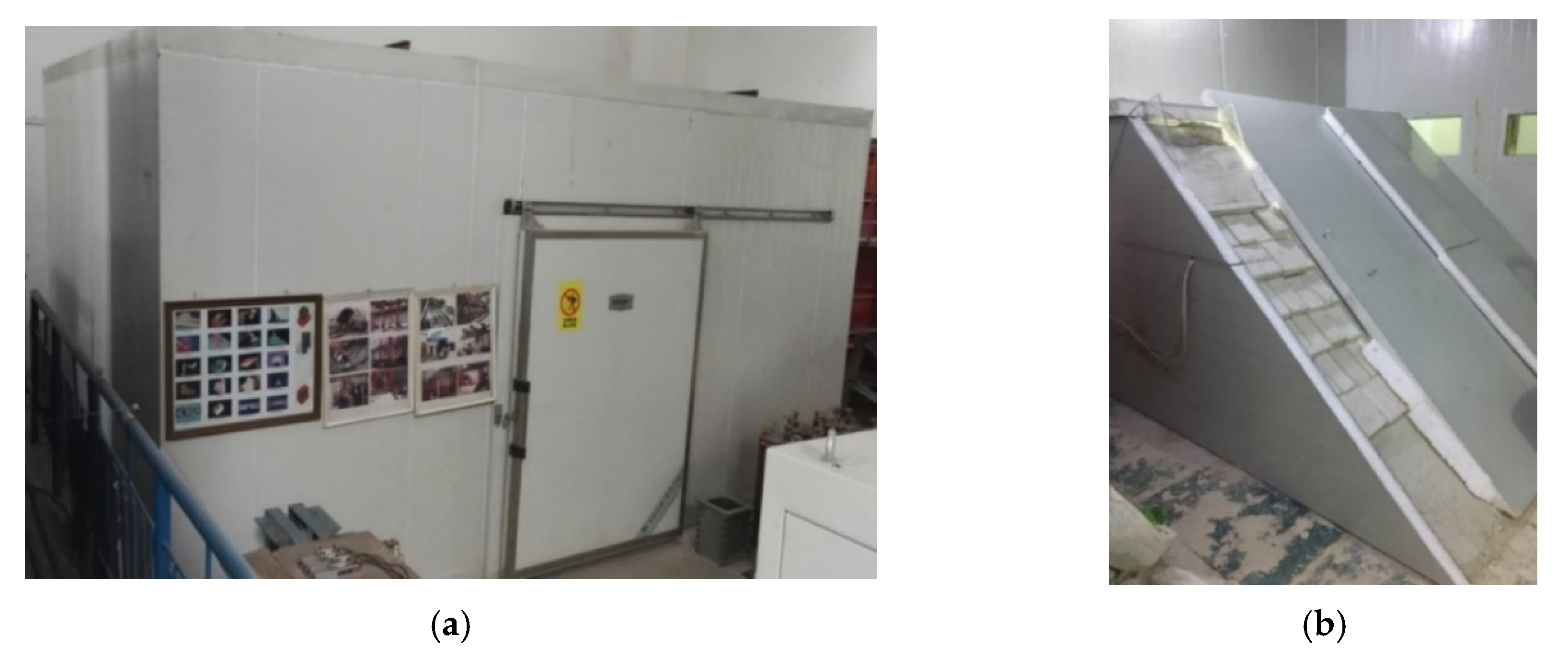


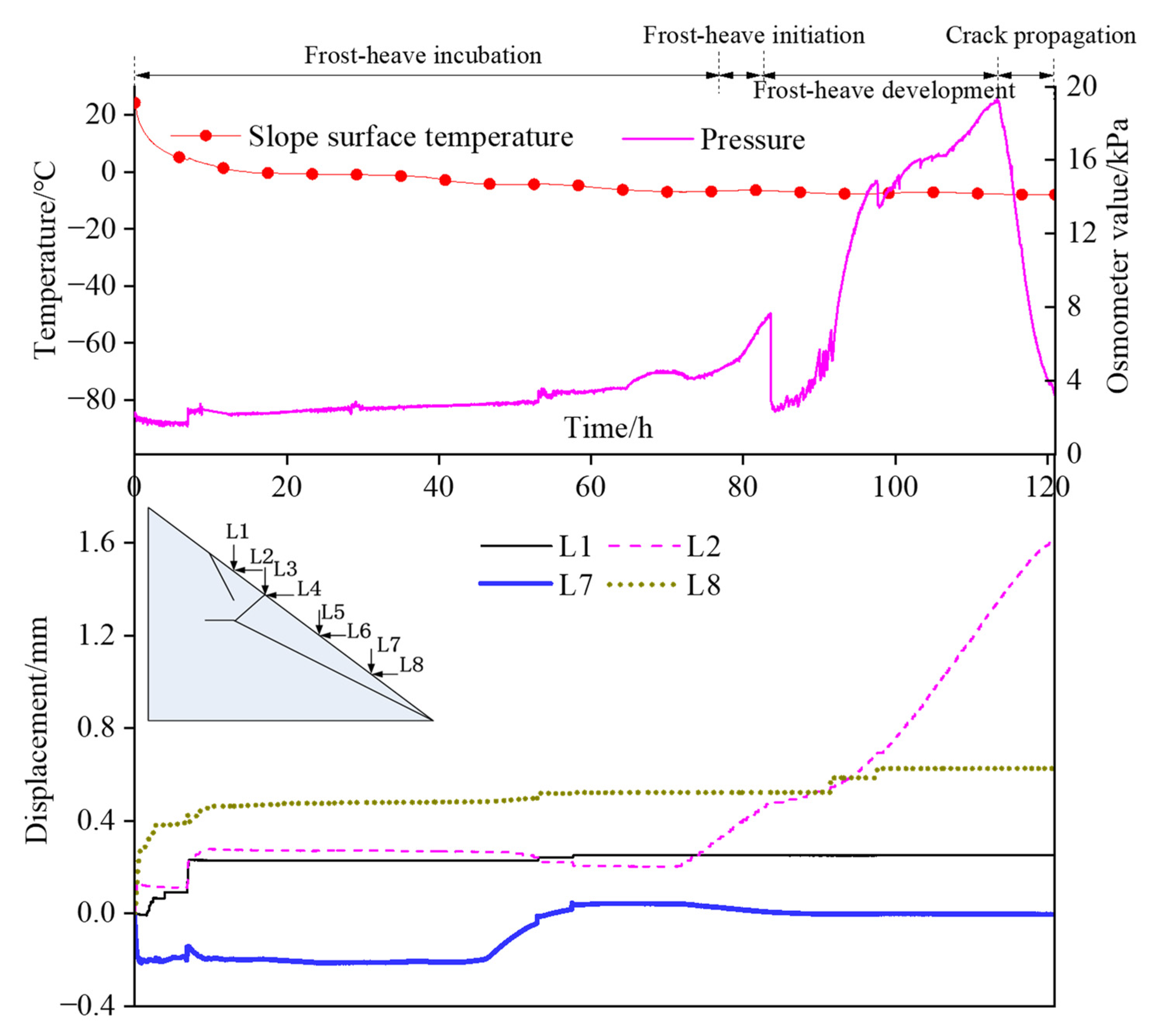
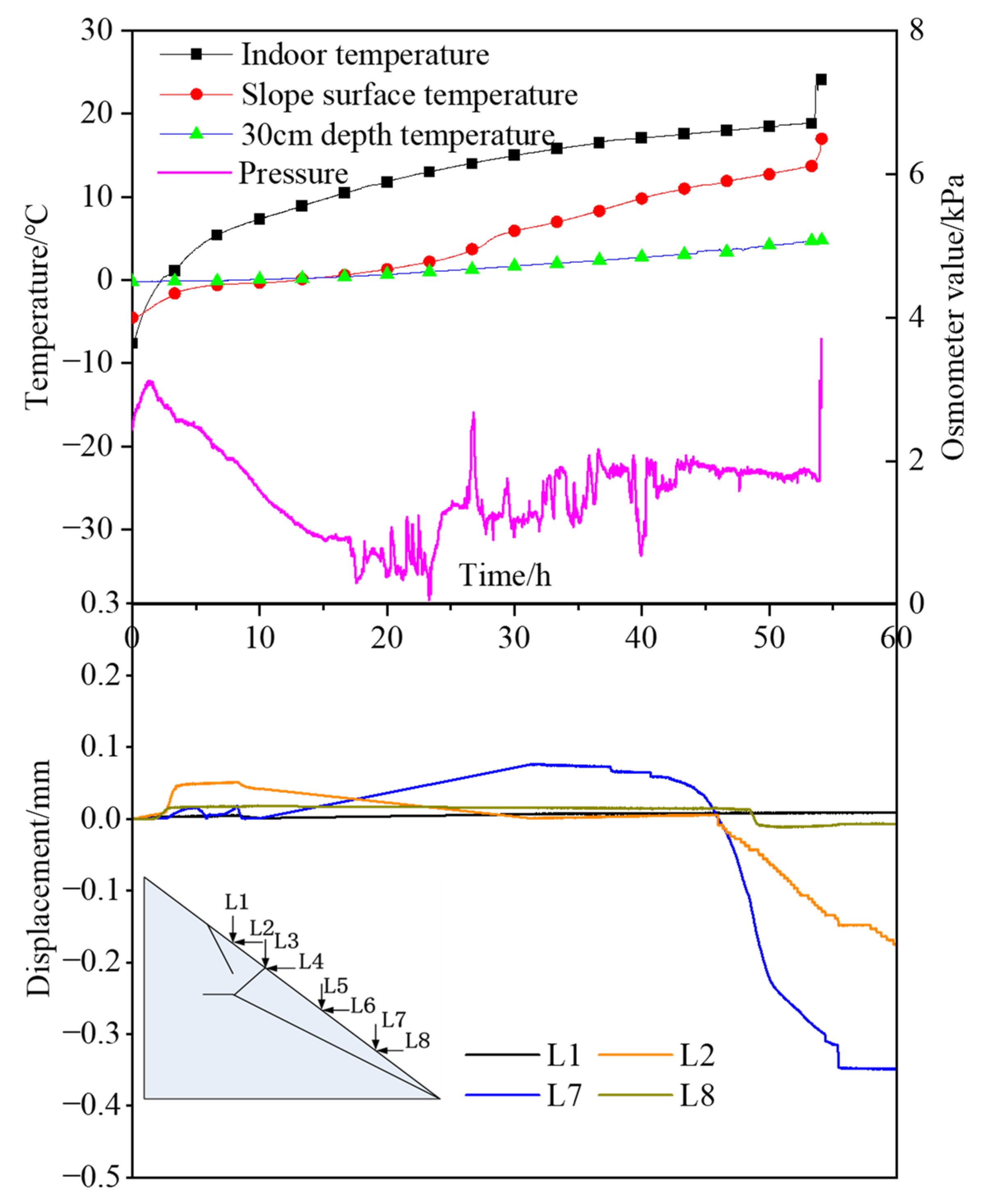
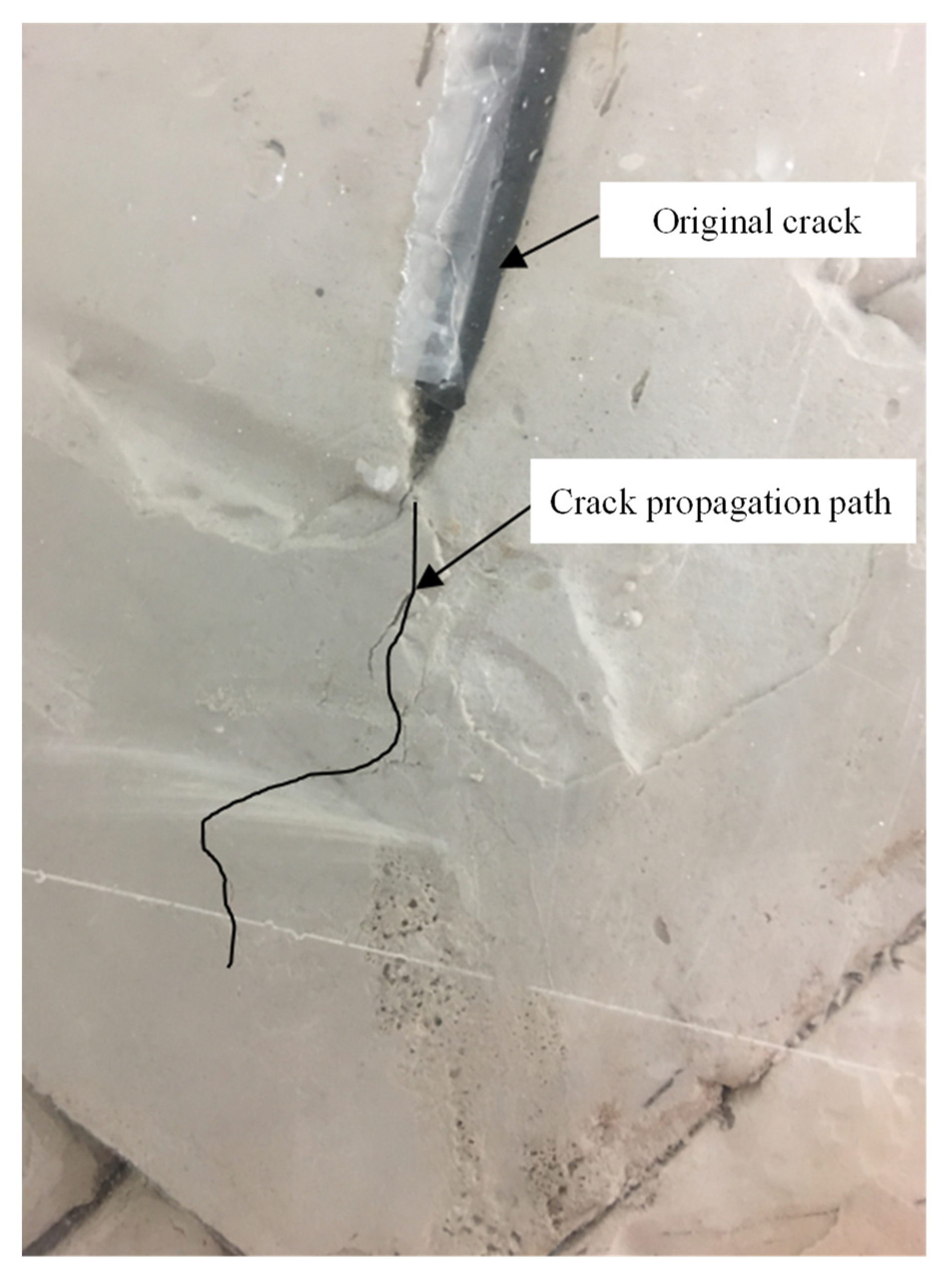
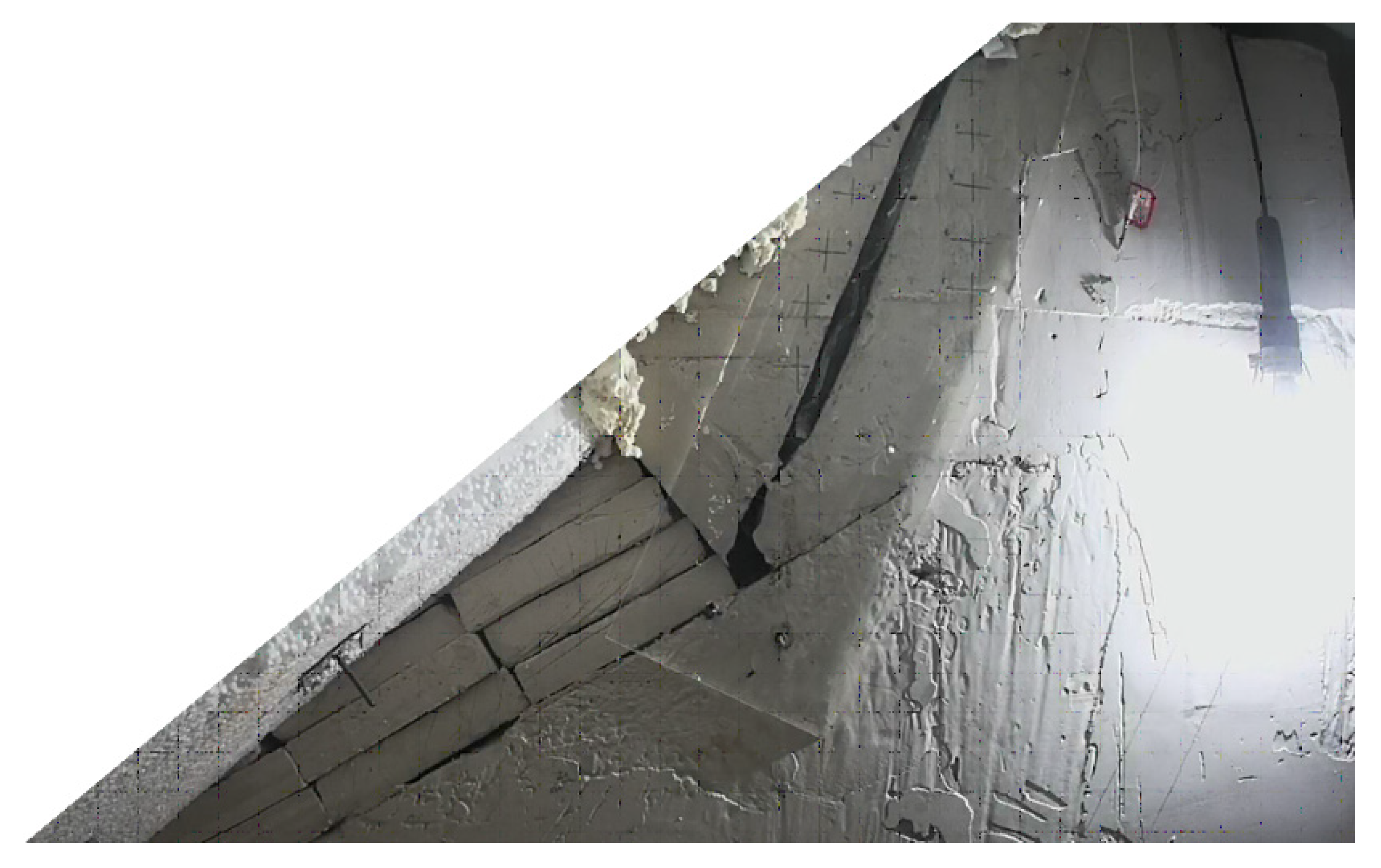

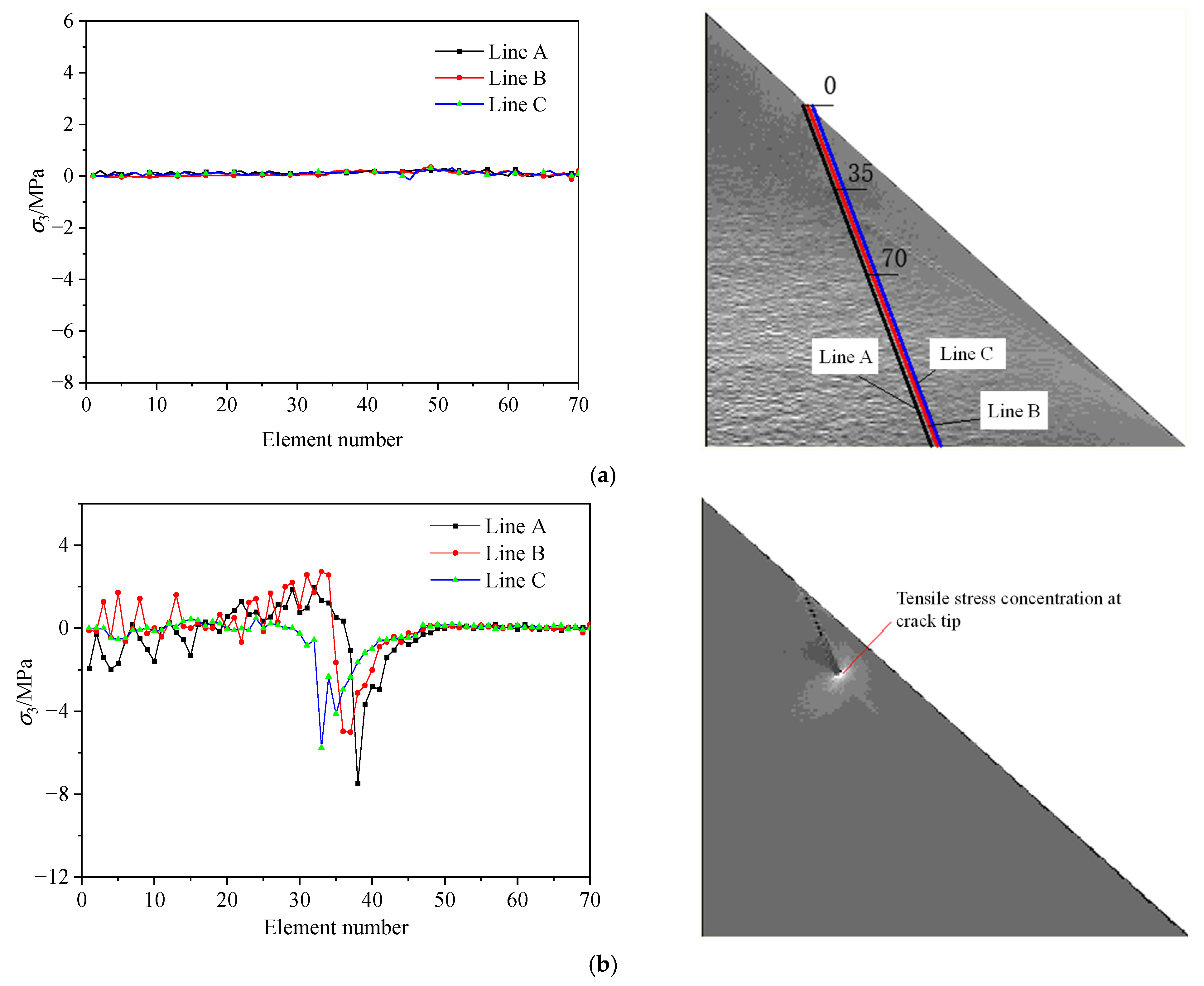
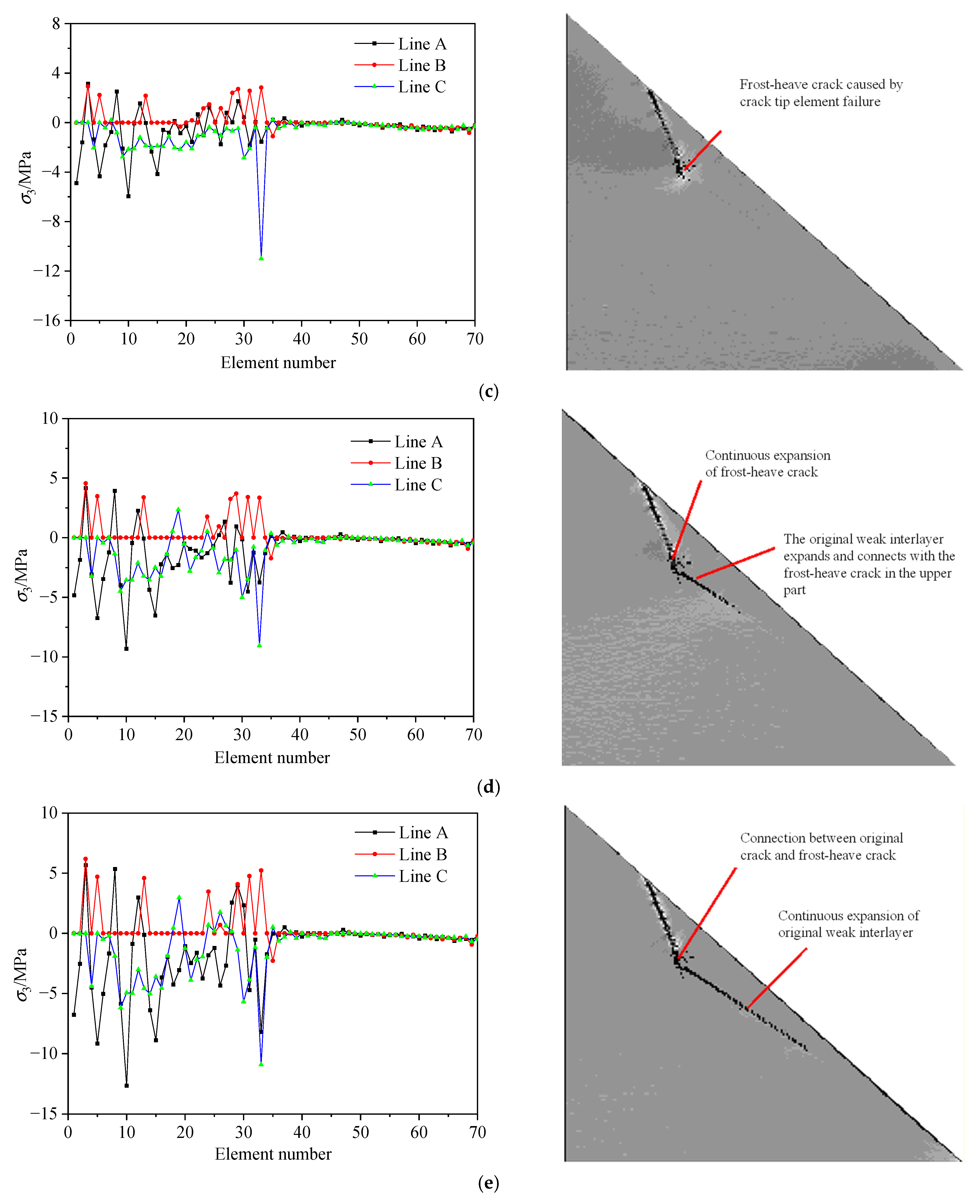
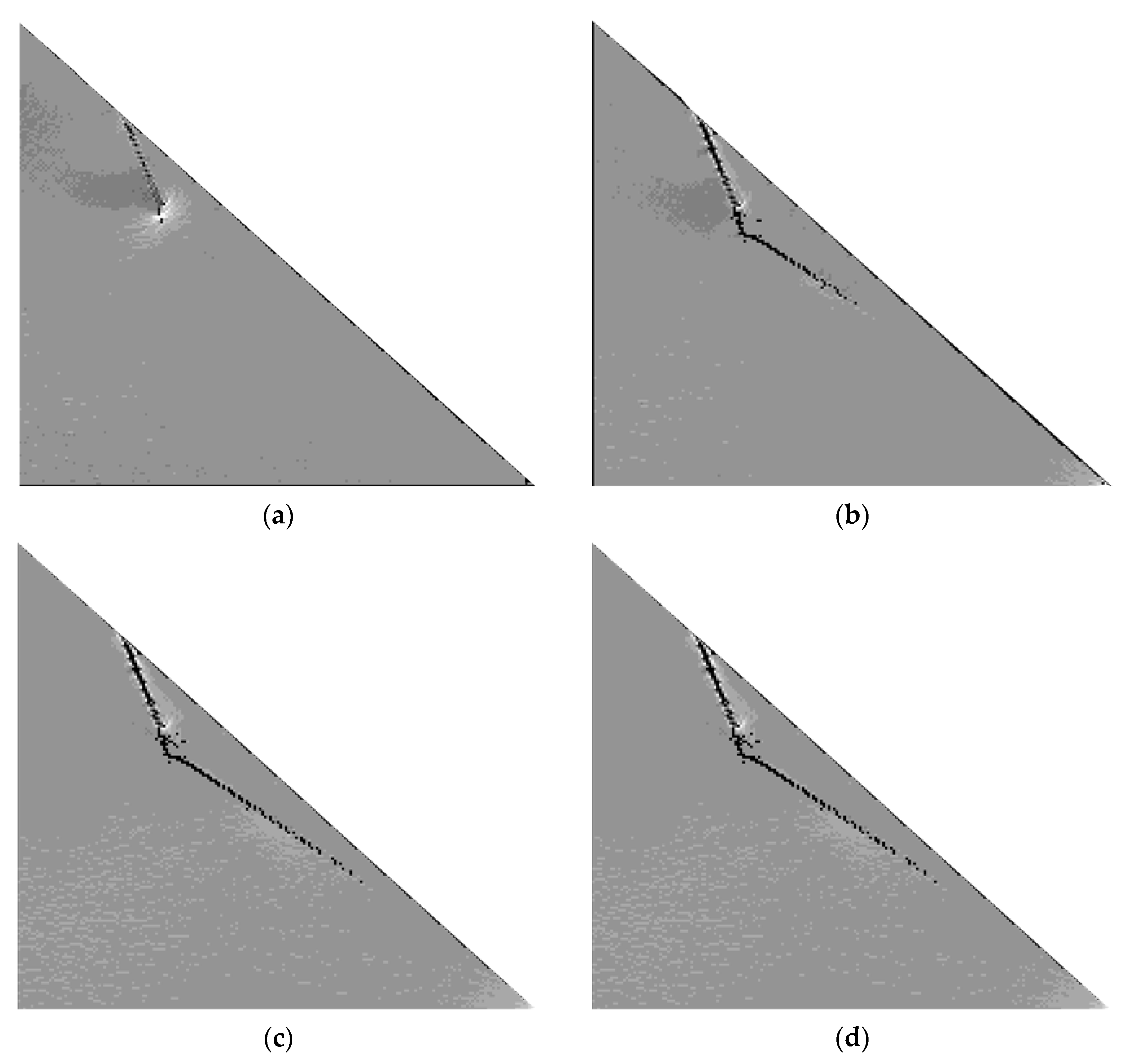
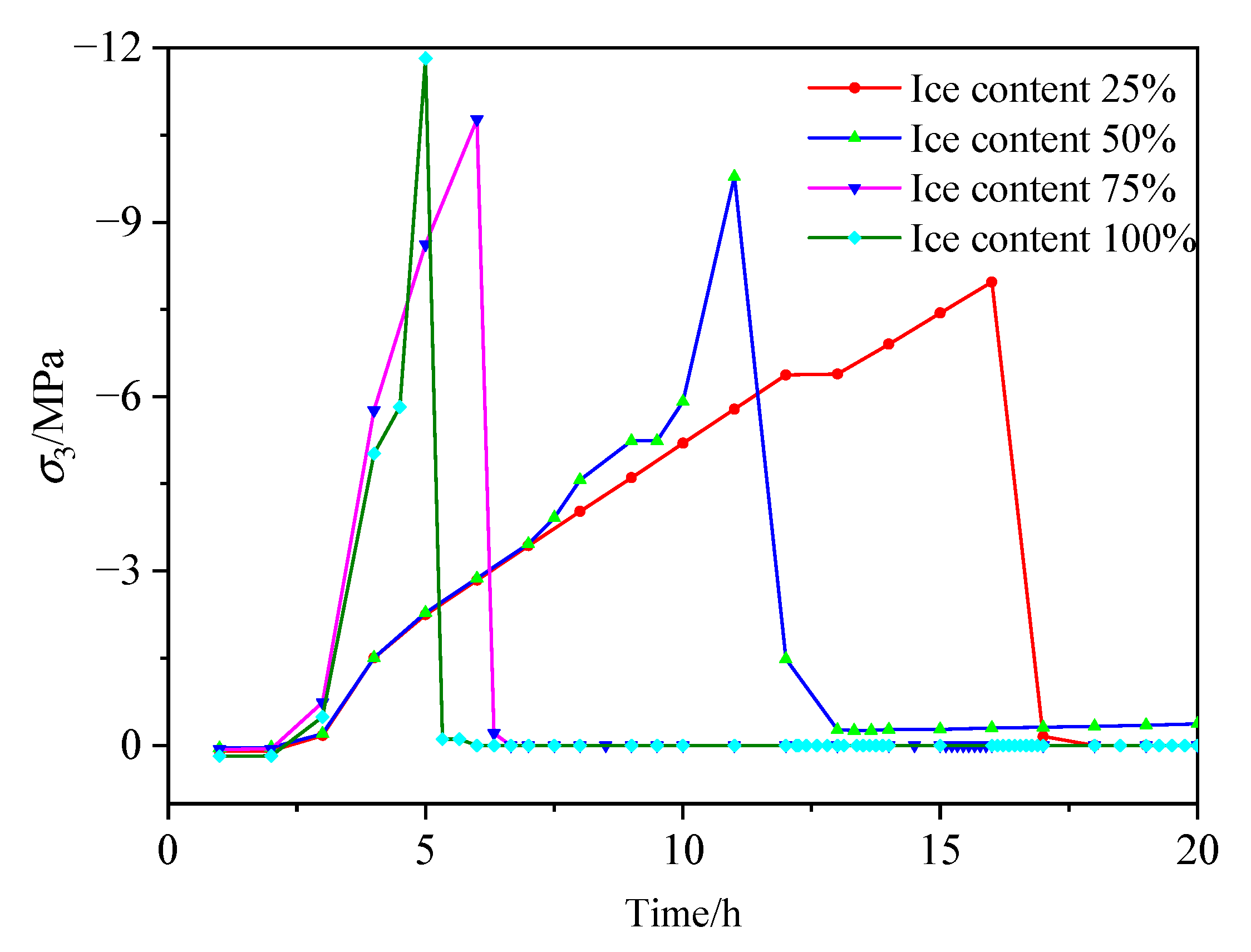
| Material Type | Unit Weight/kg/m3 | Elastic Modulus/GPa | Compressive Strength/MPa | Poisson’s Ratio | Cohesion/MPa |
|---|---|---|---|---|---|
| Indoor rock | 2710 | 38.83 | 112.28 | 0.35 | 11.1 |
| Quasi rock mass (Class III) | 2710 | 16.31 | 47.16 | 0.35 | 4.7 |
| Model material | 1656 | 0.13 | 0.49 | 0.25 | 0.04 |
| Similarity Constants | CL | Cγ | CE | CRc | Cμ | Cc |
|---|---|---|---|---|---|---|
| Actual value | 100 | 1.64 | 125.5 | 96.2 | 1.4 | 117.5 |
| Theoretical value | 100 | 1.64 | 164 | 164 | 1 | 164 |
| Materials | Thermal Capacity/(m3·°C) × 106 | Thermal Conductivity/(m·°C) | Coefficient of Thermal Expansion/°C × 10−5 | Ratio of Compression Strength to Tensile |
|---|---|---|---|---|
| Rock mass | 2.3 | 2.67 | 0.54 | 15 |
| Ice | 2.1 | 2.2 | −150 | 15 |
| Unit Weight/kN/m3 | Elastic Modulus/GPa | Compressive Strength/MPa | Poisson’s Ratio | Internal Friction Angle/° | |
|---|---|---|---|---|---|
| Class II rock mass | 27.10 | 16.31 | 47.16 | 0.35 | 67.8 |
| Class III rock mass | 27.10 | 16.31 | 47.16 | 0.35 | 67.8 |
| Class IV rock mass | 27.00 | 12.30 | 39.13 | 0.38 | 65.7 |
| f2 | 24.00 | 1.5 | 6 | 0.4 | 30 |
| Ice | 9.17 | 0.6 | 6 | 0.35 | 20 |
| Materials | Unit Weight kN/m3 | Elastic Modulus E/GPa | Compressive Strength σ/MPa | Poisson’s Ratio ν | Internal Friction Angle φ/° |
|---|---|---|---|---|---|
| Class II rock mass | 27.10 | 16.31 | 47.16 | 0.35 | 67.8 |
| Class III rock mass | 27.10 | 16.31 | 47.16 | 0.35 | 67.8 |
| Class IV rock mass | 27.00 | 12.30 | 39.13 | 0.38 | 65.7 |
| f2 | 24.00 | 1.5 | 6 | 0.4 | 30 |
Publisher’s Note: MDPI stays neutral with regard to jurisdictional claims in published maps and institutional affiliations. |
© 2022 by the authors. Licensee MDPI, Basel, Switzerland. This article is an open access article distributed under the terms and conditions of the Creative Commons Attribution (CC BY) license (https://creativecommons.org/licenses/by/4.0/).
Share and Cite
Zhu, J.; Xu, D.; Wang, B.; Li, C. A Study on the Freeze–Thaw Damage and Deterioration Mechanism of Slope Rock Mass Based on Model Testing and Numerical Simulation. Appl. Sci. 2022, 12, 6545. https://doi.org/10.3390/app12136545
Zhu J, Xu D, Wang B, Li C. A Study on the Freeze–Thaw Damage and Deterioration Mechanism of Slope Rock Mass Based on Model Testing and Numerical Simulation. Applied Sciences. 2022; 12(13):6545. https://doi.org/10.3390/app12136545
Chicago/Turabian StyleZhu, Jiebing, Dongdong Xu, Bin Wang, and Cong Li. 2022. "A Study on the Freeze–Thaw Damage and Deterioration Mechanism of Slope Rock Mass Based on Model Testing and Numerical Simulation" Applied Sciences 12, no. 13: 6545. https://doi.org/10.3390/app12136545






